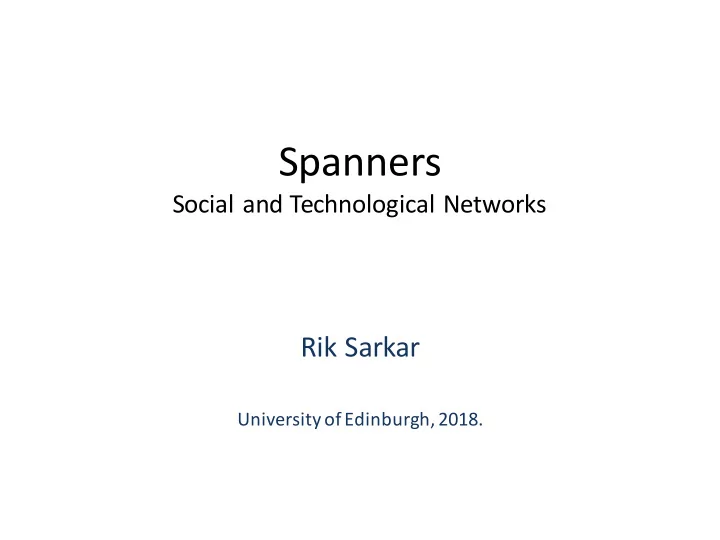

Spanners Social and Technological Networks Rik Sarkar University of Edinburgh, 2018.
Distances in graphs • Suppose we are interested in finding distances, shortest paths etc in a weighted graph G • The problem: A graph can have 𝑜 " edges. • Any computation is expensive • Storage is expensive
Idea: use a “similar” graph with fewer edges • A spanning graph H of a connected graph G: – H is connected and has the same set of vertices • Construct an H with fewer edges
Stretch • Suppose 𝑒 $ is the shortest path distance in G • Suppose 𝑒 % 𝑣, 𝑤 = 𝑡 ⋅ 𝑒 $ 𝑣, 𝑤 • S is called the stretch of distance between u,v • The idea is to have compressed network H with small stretch and few edges
Spanners • Suppose 𝑒 $ is the shortest path distance in G • H is a 𝑢 -spanner of G if: • 𝑒 % 𝑣, 𝑤 ≤ 𝑢 ⋅ 𝑒 $ 𝑣, 𝑤 – A multiplicative spanner – The stretch of the spanner is 𝑢 • More generally, H is a (𝛽, 𝛾) -spanner of G if: • 𝑒 % 𝑣, 𝑤 ≤ 𝛽 ⋅ 𝑒 $ 𝑣, 𝑤 + 𝛾
Examples Images from: http://cs.yazd.ac.ir/farshi/Teaching/Spanner- 3932/Slides/GSN-Course.pdf
Examples • Compress road maps and still find good paths • Compress computer/communication networks and get smaller routing tables • “Bridges” are part of spanner • Small set of distances among moving objects. – To detect possible collisions – A “short edge” must always be in the spanner – Thus, we need to only check edges in the spanner
Simple greedy algorithm • Given graph G=(V, E) and stretch t • We want to construct H=(V, E’) • Sort all edges in E by length • Proceed from shortest to longest edge – Take edge e=(u,v) – If 𝑒 % 𝑣, 𝑤 > 𝑢 ⋅ 𝑒 $ 𝑣, 𝑤 , add e to E’ • Output H
Geometric spanner • Suppose we have only a set of points in the plane, and no graph (e.g. position of robots) • Then the same algorithm applies – With G as the complete graph with, planar distance as the edge length
H is a spanner • Claim: 𝑒 % 𝑣, 𝑤 ≤ 𝑢 ⋅ 𝑒 $ 𝑣, 𝑤 • If (u,v) is an edge in G, then this holds by construction. • If not, suppose P is the path between them of length 𝑒 $ 𝑣, 𝑤 • For each edge 𝑏, 𝑐 ∈ 𝑄 , the claim holds. – Therefore. It holds for the sum of their lengths.
Number of edges • Theorem: • The greedily constructed 𝑢 -spanner has • 𝑜 89 : ;<= edges • Proof: Ommitted
Deformable spanners • Suppose we have n points in ℝ @ • We want to compute a good spanner – With stretch 1 + 𝜗 – Number of edges 𝑜/𝜗 @
Discrete centers • Give a radius 𝑠 • A set S of discrete centers is a subset of V • Such that: – Any point of V is within distance 𝑠 of some 𝑡 ∈ 𝑇 . – Any two points 𝑡 8 , 𝑡 " ∈ 𝑇 are at least 𝑠 apart • That is, a set of balls with far apart centers, that covers all points
Discrete center hierarchy • Compute a set 𝑇 F of discrete centers – For each 𝑠 = 2 F – Such that 𝑇 F ⊆ 𝑇 FI8 • Start from smallest distance between a pair of points – At this lowest level each node is a center • Highest level is diameter of the set
Spanner • Suppose s, t ∈ 𝑇 F are centers • Add edge s, t if 𝑡𝑢 ≤ 𝑑 ⋅ 2 F – For 𝑑 = 4 + 16/𝜗 • Take the union of edges created at all levels • To get a graph G
Theorems • G is a (1 + 𝜗) spanner – That is, for any two points p and q, there is a path in G of length at most 1 + 𝜗 𝑞𝑟 • G has 𝑜/𝜗 @ edges • If the ratio of diameter to smallest distance is 𝛽 , then each node has O((log 𝛽)/𝜗 @ ) edges
Useful properties • Applies to metrics of bounded doubling dimension • Relatively small number of edges • Each node has a small number of edges – Efficient in checking for collisions and near neighbors – Each robot has to keep small amount of information • Can be updated easily as nodes move, join, leave – Hence the name “deformable” • Multi-scale simplification of the network – Gives a summary of the network at different scales – An important topic in current algorithms and ML – Computation for large datasets need simplified data
• There are other more complex algorithms • Areas of research: – Specialized graphs – Fault–tolerant spanners – Dynamic spanners – for changing graphs – …
Course • No class on Friday 23 rd Nov • No office hours Thursday 22 nd Nov • Final class on Tuesday 27 th : review – We will discuss the course in general – What to expect in exam
Recommend
More recommend